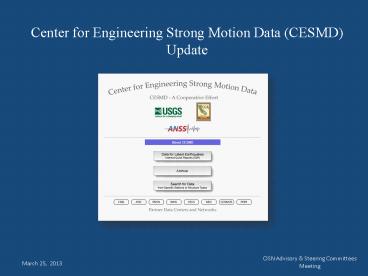Center for Engineering Strong Motion Data (CESMD) Update PowerPoint PPT Presentation
Title: Center for Engineering Strong Motion Data (CESMD) Update
1
Center for Engineering Strong Motion Data
(CESMD) Update
2
CESMD Objectives and Operation
- Established as part of CISN in 2006 as joint
effort of US Geological Survey and California
Geological Survey - Collect, archive, and disseminate records of
ground and structural responses to earthquake
strong motions of engineering interest - Internet Quick Reports (IQR) of strong motion
data within minutes for rapid response to
earthquakes - Provide information about station, site, geology,
etc. - Provide online search access to CESMD archive
principally for US data also called Engineering
Data Center (EDC) - Provide integrated search and virtual access to
global strong-motion records through the Virtual
Data Center (VDC)
CISN Advisory Steering Committees Meeting
3
Two Components of CESMD
4
Automated Import of Records to IQR
- Task
- Records from CISN and other networks, each with a
variety of instrument types - Provide a coherent presentation of strong motion
records, with Quality Assurance - Full records, ShakeMap uses peak values
- Automated processing and import of CISN
strong-motion records
5
CESMD Internet Quick Report (IQR)for US Data
- For earthquakes in CISN region, records are
available via IQR automatically within minutes
after Mgt3.5 earthquakes, records w/ PGAgt0.5g - 78 automatically generated IQR in 2012
6
Small Records Served via FTP
- Small records (Mlt3.5, and Mgt3.5 with PGAlt0.005g)
- FTP(ftp//140.174.65.75/Small_Record_and_Earthqua
kes) - Users can access this ftp site through the link
named Small Records FTP in the EDC search page - Records from 128 earthquakes in 2012 in FTP
7
New Face of the Strong-Motion Virtual Data
Center (VDC)
- VDC has been incorporated into CESMD (originally
developed at UCSB) - Metadata upload process now uses standard
format, is more automated - VDC has been updated with the addition of M5.0
US and New Zealand records since 2007 - COSMOS promotes international SM networks making
data available to VDC, development of global
metadata standards
8
(No Transcript)
9
Japan K-NET and KiK-net records now in VDC
10
VDC Projects in Progress
- Software completed to convert Japanese K-NET and
KiK-net data for uploading record metadata
uploading to VDC now underway (records from 24
earthquakes already uploaded) - Criteria Mgt5, at least 1 comp gt 10g, depthlt100
km - Only M9 strong motion records that exist
- Collaborating with ITACA (Italian Accelerometric
Archive) to finalize conversion of ITACA records
to COSMOS format - Interacting with other strong-motion networks
internationally to develop protocols for serving
their data through the VDC - Partnering with COSMOS to develop new tools for
VDC, establish standards for data and metadata
quality control
11
CESMD ArchiveNo. of Earthquakes vs Magnitude
Records from 296 earthquakes with Mgt4.0 in CESMD
12
CESMD ArchiveNo. of Records vs Magnitude
About 9270 station records from earthquakes with
Mgt4.0 in CESMD
13
- CESMD Summary
- Provides access to strong-motion data of
engineering interest from CISN, the US and other
seismically active countries - The Strong-Motion Virtual Data Center (VDC) is
operational again US and New Zealand data for M
5 since 2007 have been loaded - Currently updating VDC to include Japan K-NET and
KiK-net data (close to completion) - Ground and some structural strong-motion data are
processed and posted from CISN and other networks
to aid in response to earthquakes and to guide
future seismic design improvements

